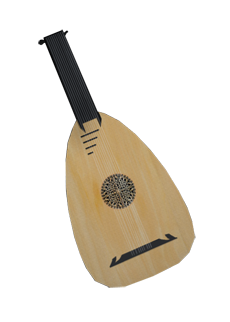Object Descriptions Ground Floor Parlor
Lute
The lute was a popular renaissance instrument similar to the modern-day guitar.
Eric Klingelhofer’s excavations of Kilcolman in the mid-1990s uncovered a tuning peg for a lute or similar stringed instrument. The find was located in a stratification level that could be contemporary with Spenser’s occupation of the site. Although its dating is uncertain, it may have been in use in Spenser’s household there in the 1590s.
Featured here is “Mr. Dowland’s Midnight” by the Elizabethan lutenist John Dowland (played by Christopher Morrongiello; reproduced with permissions).

Literary Connections
A poem attributed to Spenser and published posthumously by James Ware in 1633, “Verses upon the said Earles Lute,” is reported to have been carved upon the lute of Richard Boyle, first earl of Cork. Boyle was a cousin of Spenser’s second wife, Elizabeth Boyle, who lived with Spenser at Kilcolman. Richard Boyle was involved in the English administration in Munster from the 1580s on, and he eventually purchased (in 1602) the Munster holdings of Sir Walter Raleigh, which helped him (Boyle) to become fabulously wealthy and to buy his earldom from the British monarch, James I.
Spenser’s poem reads as follows:
Whilst vitall sapp did make me spring,
And leafe and bough did flourish brave,0.231.2013
I then was dumbe and could not sing,
Ne had the voice which now I have:
But when the axe my life did end,
The Muses nine this voice did send. (“Verses upon the said Earles Lute”)
What does this tell us about Spenser’s life as a poet and a planter? It indicates that the felling of trees is a necessary sacrifice that leads to the making of instruments, such as the lute, which create (or accompany) the “voice” of the “Muses nine.” The nine Muses in classical tradition are the goddesses who inspire learning and the arts, including poetry and history. Spenser refers to the Muses often in his poetry and wrote a set of poems entitled Tears of the Muses, published in his Complaints volume (1591). But the poem does more than praise instruments; it identifies industrial activity on the land as the source of art. Boyle’s lands were famous for their timber, and so Spenser connects tree-cutting, which made things like lutes, with the inspiration of poets who earned their livelihood from the land (and who were, presumably, patronized by wealthy men such as Boyle).
The most famous of mythological poets was Orpheus, whose song in nature calmed the beasts and made the trees bend to hear him. Spenser’s famous refrain to his wedding poem, “Epithalamion,” celebrates how the “woods” around him in Munster “eccho” and “ring” to his song. In such a moment the bridegroom-poet, Spenser, is like Orpheus, who is able to charm the landscape and make it harmonize with, or echo, his song. By analogy, whoever played the earl of Cork’s lute would be in the position of Orpheus, making the woods (including the instrument which is made out of wood) echo and harmonize with poetic song. Orpheus was himself torn apart by savage forces (by orgiastic maenads, or female celebrants of Bacchus) and his head and harp floated down a river. But the ideal concept of the power of his song lives on [see the reference to Orpheus’ harp on a river in Spenser’s Ruines of Time 604-9, published in Complaints (1591), wherein the Orphic harp is that of Sir Philip Sidney. See also Rivers].
Not all music was pleasant to Spenser’s ears. Music could also be a luxurious distraction from more virtuous deeds. For example, in The Faerie Queene, in the vainglorious House of Pride, a place ruled by the queen Lucifera, we witness a royal feast “in commune hall.” Here we find
… many Minstrales maken melody,
To driue away the dull melancholy,
And many Bardes, that to the trembling chord
Can tune their timely voices cunningly,
And many Chroniclers, that can record
Old loues, and warres for Ladies doen by many a Lord. (FQ I.v.3.4-9)
One can imagine Spenser spending many a long day and evening at Kilcolman playing and listening to songs accompanied by lute, and/or listening to Irish “bards” (as Spenser’s spokesman, Irenius, says he has done in the View, pp. 72-5), and/or writing his own chronicle of “Fierce warres and faithfull loues,” as he calls his historical epic, The Faerie Queene (FQ I.Proem.i.9). Such art was only worthwhile, however, if it led to virtuous action, including work on the land.
Bibliography:
James Neil Brown, “Orpheus.” The Spenser Encyclopedia. Ed. A. C. Hamilton (Toronto: U of Toronto P, 1990), 519-20.
Andrew Hadfield, Edmund Spenser: A Life (Oxford: Oxford UP, 2012): 220.
Eric Klingelhofer, Castles and Colonists: an Archaeology of Elizabethan Ireland (Manchester: Manchester UP, 2010): 126.
—, “Edmund Spenser at Kilcolman Castle: the archaeological evidence.” Post-Medieval Archaeology 39.1 (2005), 133-54.
David Lee Miller, “The Earl of Cork’s Lute.” Spenser’s Life and the Subject of Biography. Ed. Judith Anderson, Donald Cheney and David Richardson (Amherst: U of Massachusetts P, 1996), 146-71.
“Mr. Dowland’s Midnight“ in the Margaret Board Lute Book, Royal Academy of Music, Robert Spencer Collection, MS 603: f. 26v.
Bruce Pattison, Music and Poetry of the English Renaissance, 2nd ed. (London: Methuen, 1970): 65-7, 142-4.
Links:
http://www.cs.dartmouth.edu/~lsa/ [2/19/16]
[Lute Society of America]